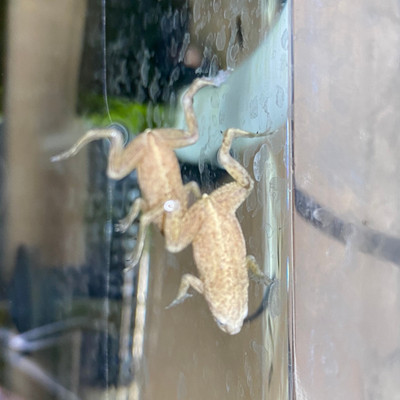Blonde African Dwarf Frogs
Posted by Max Gandara on on 16th Apr 2025
Blonde African Dwarf Frogs
When it comes to keeping aquatic pets, many enthusiasts are drawn to the intriguing and unique qualities of frogs, particularly the Blonde African Dwarf Frog. These delightful creatures can add a splash of excitement and curiosity to any home aquarium. In this blog, we'll explore the fascinating aspects of these frogs, from their origins and characteristics to their care and habitat needs.
Origins and Characteristics
Blonde African Dwarf Frogs, scientifically known as Hymenochirus curtipes, are a fascinating variant of the more common African Dwarf Frog. Native to the Congo region in Africa, these frogs have adapted to a wide range of aquatic environments, from slow-moving rivers to still ponds.
What sets the Blonde African Dwarf Frog apart is its distinctive, lighter coloration. Unlike their darker counterparts, these frogs exhibit a pale, almost golden hue, which adds a unique aesthetic appeal to their appearance. Despite their small stature, usually growing no more than 1.5 inches in length, they possess a lively and engaging demeanor that captivates observers.
Ideal Habitat and Tank Setup
Creating a comfortable and safe environment is crucial for the health and happiness of Blonde African Dwarf Frogs. Here are a few essentials to consider when setting up their habitat:
-
Tank Size: A minimum of a 10-gallon tank is recommended for these frogs, providing ample space for swimming and exploring.
-
Water Quality: Maintaining clean water with a stable pH level between 6.5 and 7.5 is essential. Regular water changes and a good filtration system are crucial for their well-being.
-
Substrate: A soft, fine substrate like sand or small smooth gravel is ideal, as it prevents injury to their delicate skin.
-
Plants and Decor: Live plants and hiding spots, such as caves or driftwood, offer enrichment and security for these timid creatures.
Diet and Feeding
Blonde African Dwarf Frogs are primarily carnivorous, feeding on a diet of small, protein-rich foods. Some suitable options include:
-
Bloodworms: A favorite among many aquatic pets, bloodworms provide essential nutrients.
-
Brine Shrimp: These are another excellent choice, offering a balanced diet for these frogs.
-
Frog Pellets: Specially formulated pellets ensure they receive all necessary vitamins and minerals.
Feeding should be done carefully, with small amounts offered several times a week to prevent overfeeding and maintain water quality.
Behavior and Social Interaction
These frogs are social creatures, thriving in groups rather than solitary environments. They are known for their quirky behaviors, such as floating motionless at the water's surface or darting around the tank. Observing their interactions can be a source of endless entertainment for owners.
Health and Maintenance
To ensure the health and longevity of Blonde African Dwarf Frogs, regular monitoring and maintenance are essential. Be vigilant for any signs of illness, such as lethargy, bloating, or changes in skin texture. Consulting with an aquatic veterinarian can provide guidance if health issues arise.
Conclusion
Blonde African Dwarf Frogs are a delightful addition to any aquarium, offering both beauty and entertainment. With proper care and attention to their unique needs, these captivating amphibians can thrive and bring joy to their owners for years to come. Whether you're a seasoned aquarist or a beginner looking to expand your aquatic family, these frogs present a wonderful opportunity to explore the wonders of underwater life.

